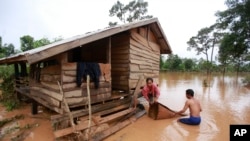Cambodian officials and community activists living in riverine communities have applauded the Lao government's recent decision to review all hydropower dam investments after a devastating dam breach last month caused serious effects downstream in Cambodia.
On July 23, a saddle dam in the large-scale Xe-Pian Xe-Namnoy hydropower project in southern Laos burst its walls and flooded a vast swath of land in Attapeu province. The waters flowed into the Sekong River, a Mekong tributary, causing serious repercussions for communities in northern Cambodia along the Sekong and Mekong.
Long Socheat, a representative for the Tonle Sap Lake Community, a group of community activists who advocate protecting natural resources in freshwater lakes and rivers, told VOA Khmer that the disaster seriously concerned Cambodians whose relied on fishery resources.
He said he was delighted to hear that Laos would more carefully review dam projects, but added that the best solution for Cambodians would be to stop all plans to build more dams, which he said had a serious impact on fisheries.
“If Lao suspends the construction of more dams, Cambodian people living along the river will applaud. How happy we would be, if Lao stopped building dams,” he said.
According to an August 15 statement by the Mekong River Commission (MRC), which is based in the Lao capital of Vientiane, Laos will review all existing and under-construction dam projects and suspend the consideration of all new hydropower investments in the aftermath of the Xe-Pian Xe-Namnoy dam break.
The head of the MRC, Pham Tuan Phan, was quoted in the statement as saying, “As a regional intergovernmental organization, we wholeheartedly welcome the decision and initiative of the Lao Prime Minister to review all the dams and re-examine all new hydropower investments.”
Te Navuth, secretary general of the Cambodia National Mekong Committee, told VOA Khmer on Friday that Cambodia welcomed Laos’ more cautious new stance on dam-building.
“We welcome; we welcome. Normally, [they] want to create safety. This is important for the Lao side, which formed a commission to inspect all dams that were constructed in order to avoid the kind of mistakes that we saw at Xe-Pian Xe-Namnoy, which accidentally broke down. So, they need to re-check,” he said.
“Secondly, the Lao side said that they will suspend for a while with the new projects, and we are waiting to hear confirmation from Lao government for the dam projects that were already put into consultation with member countries, such as the Pak Lay dam project. We are waiting for more specific confirmation from them,” he added.
He declined to comment on whether Cambodia should also stop building more dams after the incident in Lao, referring questions to the Ministry of Mines and Energy.
Victor Jona, a spokesman for the ministry, could not be reached for comment.
The dam breach killed more than 30 people in Laos, while more than 100 are still missing. About 5,000 people in Siem Pang district of Cambodia's Stung Treng province, which lies along the Lao border, had to be evacuated from their homes.
Meas Chanty, a fisherman from Thma Keo commune of Siem Pang district, which was flooded in the dam breach, said the accident had serious consequences for his community.
He said many rice fields were destroyed by the inundation and stressed that community members in Siem Pang hoped the Lao government would stop future dam construction.
“Our side worries very much, and we don’t want to continue construction because it had bad effects on us. We almost couldn’t escape the flooding because we live close” to Laos, he said.
He said what Cambodian fishermen really need is not electricity but fish—which scientists say are being killed by excessive damming of the region’s vital rivers.
“Electricity is not really important for the families living close to the dams because [dam-building] caused a lot of effects,” he said.
Meas Chanty, who also relies on fishing in the Sekong River for his livelihood, called on the Cambodian government to take firmer protective measures as it embarks on building dams on this side of the border.
“When the flood occurred over the last few days, the people seem to worry and can't sleep at night time, and they can't eat food easily,” he said.
“I would like to request that Cambodia take any measures that could help the people, preventing such serious floods that fear could affect the lives of the people in the village,” he added.
Long Socheat of the Tonle Sap Lake Community said that the Cambodian government should learn from this incident and make sure to conduct thorough studies before the construction of any future hydropower dams.
“If we were in their situation, we wouldn’t know what to do, because it's extremely difficult when a flood occurs,” he said. “It can come by accident, separating us from our families and destroying property.”
He explained that flooding or natural resource destruction in the Mekong River also affects the Tonle Sap river and lake. Together, the river systems and the lake provide fish and livelihoods for millions of Cambodians.
“The Mekong River is like the blood of the Tonle Sap Lake,” he said. “Curbing dam construction on the mainstream of the Mekong River is crucial to preserve fishery resources in Cambodia’s rivers.”







